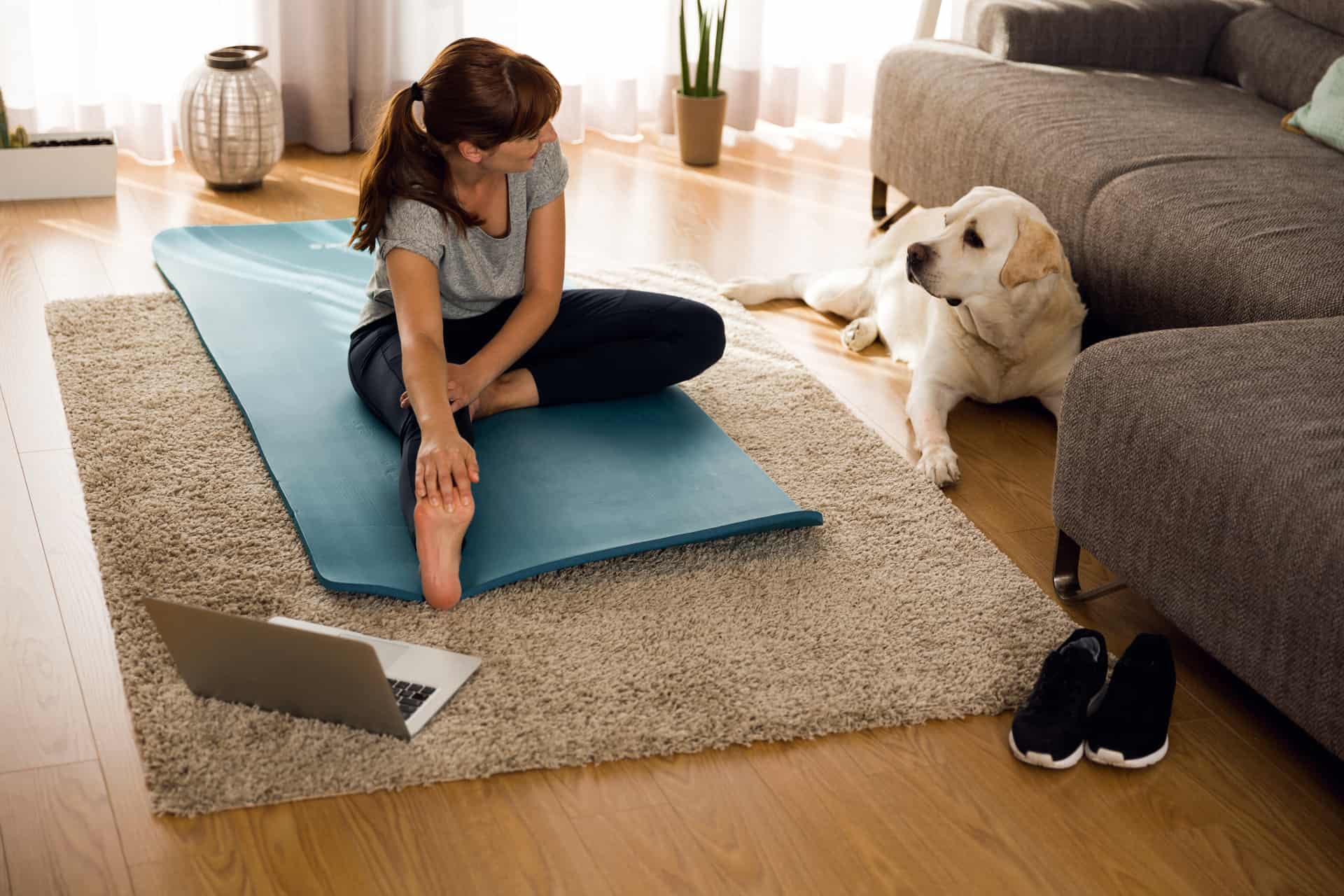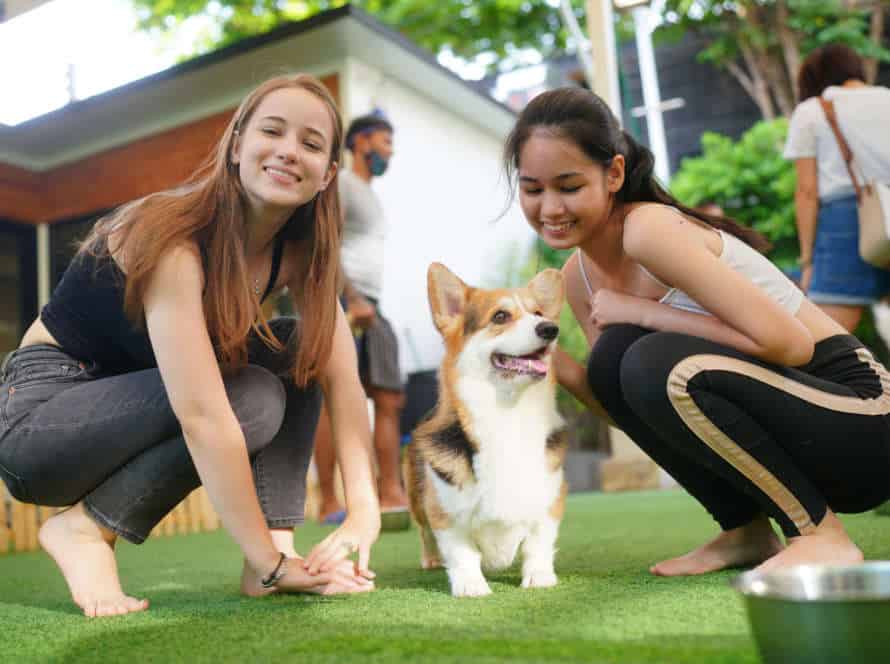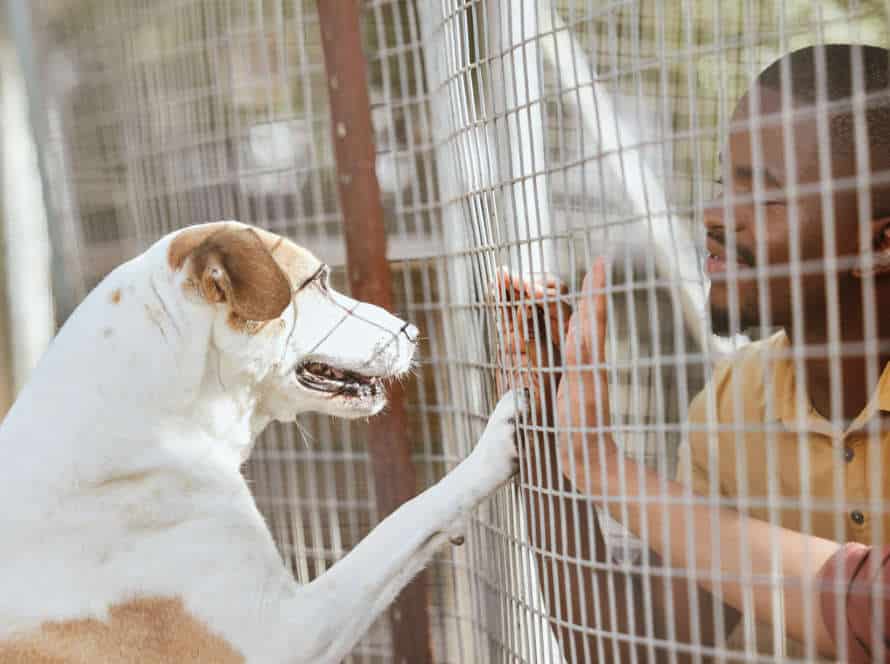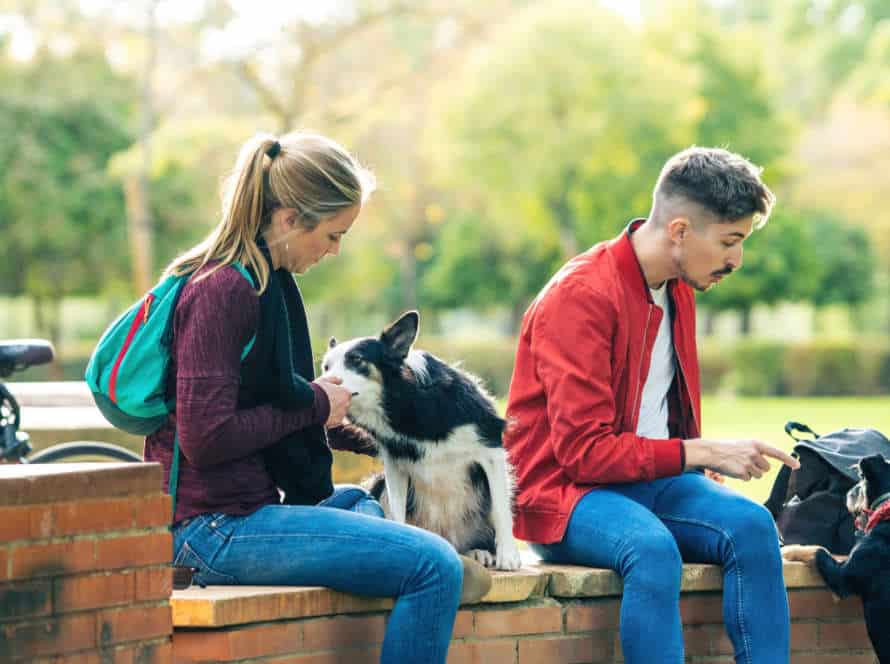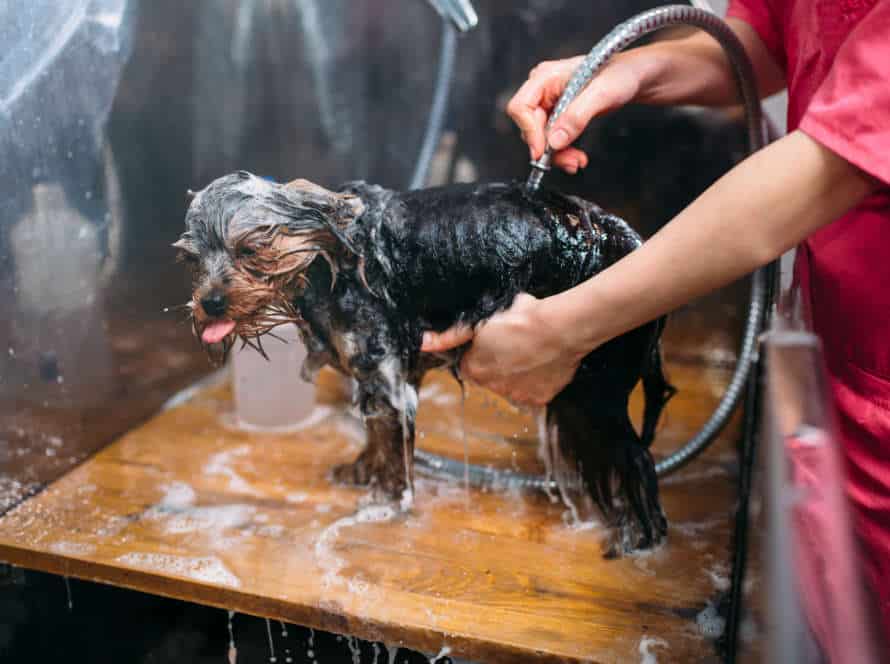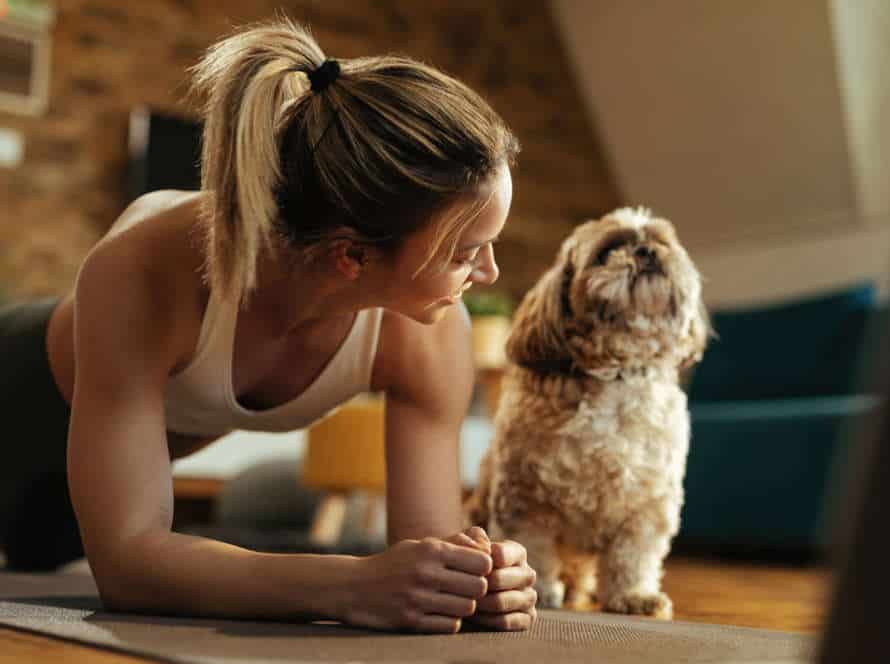Benefits of Exercise for Adult Dogs
Dogs need exercise every day to stay fit and healthy. Exercise helps adult dogs get rid of extra energy, build muscle, maintain the right weight, and make their joints strong. It can also help dogs manage their stress and worry.
Let’s explore the main benefits of exercising for adult dogs:
- Getting rid of extra energy
- Building muscle
- Maintaining the right weight
- Making joints strong
- Managing stress and worry
Reducing obesity and related health issues
Obesity is a worry for both humans and dogs. Exercising regularly can stop and lower it, and its related issues in grown-up dogs. Benefits? Weight control, joint health, heart health, and reduced stress. A good rule? Exercise for 30 minutes, twice a day. Fun ways to exercise? Brisk walks, swimming, and hiking. Plus, indoor games for bad weather or hot days. Pro Tip: Ask the vet before starting a new routine.
Improved behavior and mental stimulation
Exercising your pup is a must for their overall well-being! It gives them physical and mental stimulation. Plus, it makes them behave better!
Benefits of regular exercise for adult dogs:
- Keeps pup at a healthy weight, avoiding obesity-related health issues.
- Channels their energy in a positive way, reducing destructive and aggressive behavior.
- Builds muscle mass and helps their heart stay healthy; could lead to a longer life.
- Improves flexibility and mobility, minimizing the risk of bone-related disorders.
- Stimulates their mind, aiding boredom, anxiety, and depression.
For your pup to get enough exercise, take them on walks, runs, fetch, frisbee, and swimming. Try to do this for at least 30 mins each day. Your pup will thank you with a healthier, happier life!
Strengthening the bond between dogs and owners
Exercise is key for a strong bond between dogs and owners. The benefits for adult dogs are great; physical health and mental stimulation. Exercise helps to release dog energy and reduce aggression and destructive behaviour.
Here are the different adult dog exercise types:
- Walking: A daily walk helps get physical exercise, mental stimulation and socialization.
- Running and jogging: High-energy dogs need more intense exercise to burn off excess energy.
- Swimming: Low-impact, full-body exercise with excellent cardiovascular and muscular benefits.
- Fetch: A great way to exercise and bond with your pet.
- Other outdoor activities like hiking, camping or going to the dog park, gives exercise and fun for both you and your dog. Always consult with a vet to determine the right amount and type of exercise for your adult dog.
Types of Exercise for Adult Dogs
Exercise is a must-have for adult dogs. It keeps them fit and provides mental stimulation. For adult pooches, there are tons of exercises to partake in, such as walking, running, swimming and agility training. This guide will discuss the different types of exercise that adult canine friends should do, as well as their benefits.
Walking and Hiking
Walking and hiking are perfect exercises for adult dogs. Not only do they keep them fit, but also give them mental stimulation and strengthen the bond with you.
Here are some activities for your adult pup:
- Go for regular walks around your neighbourhood or at the park. This keeps your four-legged friend healthy, content and socialised.
- Hiking in nature is a tougher and more thrilling type of exercise. It builds your dog’s endurance, agility and confidence.
- Fetch, tug-of-war and other interactive games help your pup to let off steam and get closer to you.
- Swimming is a non-strenuous exercise which is ideal for dogs with joint pain or mobility issues.
Be sure to always make sure your pup is capable of the exercise, and start out slow and gradually increase the intensity.
Dog Park and Playdates
Give your adult pup the exercise and socializing they need, with dog parks and playdates! Here’s a guide to the exercise types:
- Brisk Walk: Great for their heart health, muscles, and weight. Start slow and gradually build up endurance.
- Jogging/Running: Burn off energy and keep a healthy weight. Start slow and build up endurance.
- Hiking: New sights, sounds, and smells. Bring water and snacks for you and your doggo!
- Swimming: Low-impact exercise for their joints. Introduce to water gradually and always supervise.
- Playdates/Dog Parks: Socialize and burn off energy with play. Make sure pup is vaccinated and well-behaved. Pro tip – Switch up their routine to keep them motivated!
Swimming and Water Activities
Swimming and water activities can be a great way to keep your adult dog active and healthy. These low-impact exercises give a full-body workout without too much stress on their joints. Here are some to try with your pup:
- Swimming: Most dogs love the water. Supervise them and start slowly if they’re new to it.
- Dock Diving: Jumping off a dock or platform helps improve agility and endurance.
- Stand-Up Paddleboarding: Paddleboard together – but start in calm waters and progress.
- Hydrotherapy: Using water for recovery from injuries or surgeries. Also helps older dogs with arthritis or joint pain.
Water activities help exercise, develop cognitive and social skills, such as swimming, teamwork, and confidence.
Creating an Exercise Plan for Your Adult Dog
Creating an exercise plan for your adult dog? Yes! Breed type, age, activity level, all need considering. This plan helps keep them fit, active and content. It’s important to make a plan that meets your dog’s physical and mental requirements. Let’s check out how to make an effective exercise plan for your adult pup!
Assessing Your Dog’s Current Health, Age, and Physical Capabilities
For your adult pup, creating an exercise routine is key. Assessing their health, age, and physical abilities is essential.
- Health: If health issues, like arthritis or heart disease, exist, a custom plan is needed. Speak with the vet first.
- Age: Elderly dogs may not be able to do as much as younger ones. Reduce frequency or duration.
- Physical Capabilities: Breed and size can impact what they can do. A small pup won’t walk as far as larger breeds. Match intensity and type of exercise to their abilities.
Assess your pup’s health, age, and physical capabilities to create a safe and effective exercise plan.
Determining the Ideal Exercise Schedule and Routine for Your Dog
Creating an exercise plan for your adult pup is key to keeping them healthy and happy! Here are some tips to consider:
- Age and size: Talk to your vet to make sure your pup is getting the right amount of exercise for their age and size.
- Breed: Different breeds have different exercise requirements due to their energy levels and health issues.
- Health conditions: If your pooch has any health conditions, tailor their exercise routine to suit.
- Sample schedule:
- 30-60 mins of moderate exercise like walking or swimming each day.
- Include playtime and mental stimulation, like fetch, tug of war, or puzzle toys.
- Break the exercise up into 20-minute chunks throughout the day.
- Always watch your furry buddy while they exercise and adjust the routine as needed.
- Pro tip: Gradually increase exercise intensity and duration to avoid injury and ensure optimal fitness.
Incorporating Variety in Your Dog’s Exercise Routine
Variety is key when it comes to exercising your pup! Here are some tips to help make exercise fun and stimulating:
- Change up the route for walks.
- Introduce new toys or objects to play with.
- Try out activities like hiking, swimming, or running.
- Alternate intensity levels – mix high-intensity play with moderate exercise.
- Incorporate obedience training to stimulate their mind.
- Speak to your vet to ensure you’re giving the right amount of exercise.
Pro tip: Consistency is key!
Safety Considerations for Exercising Adult Dogs
Exercising your adult dog is essential for their health and happiness. But you gotta be careful! Take into account the age, size, and health of your pooch before you start. Also, check the temperature and type of exercise.
Let’s discuss safety considerations more.
Preventing Dehydration and Heatstroke
To save adult dogs from dehydration and heatstroke, safety considerations should be taken when exercising. Here are some tips for prevention:
- Ensure your pup has shady spots with fresh water.
- Exercise during cooler parts of the day.
- Start off slow, then increase intensity and duration.
- Watch out for panting, drooling, or sluggishness.
- Use cooling vests, bandanas, or mats.
- On scorching or humid days, opt for indoor activities or swimming. Pro Tip- Check with your vet if you’re worried.
Avoiding Overexertion, Injuries, and Accidents
Exercising adult dogs requires safety precautions to prevent overexertion, injury and accidents. Here are some tips to ensure a safe routine:
- Consult your vet to make sure your dog is healthy enough for exercise and to decide a suitable regimen.
- Start slowly and gradually build up your dog’s endurance. Overexertion can lead to injury and heatstroke.
- Avoid exercising during the hottest parts of the day as dogs are more prone to heat exhaustion.
- Keep an eye on your dog’s fatigue and breathing. If your dog is struggling to breathe or is in distress, stop exercising right away.
- Keep your dog on a leash and be aware of your surroundings. This will avoid accidents or encounters with other animals.
By following these tips, you and your furry companion can enjoy a safe exercise experience.
Knowing When to Take Breaks or Stop Exercising
It’s vital to recognize when to give your adult dog pauses or end their workout to dodge injuries, tiredness, and other safety issues. Here’s how to decide if your pup needs a rest or if it’s time to stop:
- Monitor for indications of weariness, such as panting too much, slowing down, or lagging behind.
- Take breaks repeatedly, especially when it’s hot or when they’re doing strenuous activities.
- If your canine is showing signs of distress, e.g. throwing up, having the runs, listlessness, or strange conduct, quit exercising right away and look for veterinary help.
Remember to think of your pup’s age, breed, weight, and entire wellbeing when concocting an exercise program. Provide water and shade for your doggy during pauses, and don’t exercise during the hottest part of the day.
Pro tip: Exercise is essential for your pup’s physical and mental health, but it’s just as critical to work out safely and responsibly. By understanding your doggy’s boundaries and when to take breaks, you can assist them in staying healthy and content for years to come.
Additional Tips for Exercising Adult Dogs
Workout time! Exercise your adult pup to keep them fit and healthy. It helps maintain their weight, as well as their minds and bodies. Though there are general exercising regulations for any age dog, there are extra tips to keep in mind when exercising adult dogs.
Let’s have a peek!
Basic Training and Obedience Skills for Safety and Fun
Train your pup properly before exercising them. Recall training is a must, so they know to come when called. Leash training is key, so they don’t pull or act aggressively while walking. Teach ‘sit,’ ‘stay,’ and ‘heel’ for good behaviour.
For adult dogs, start slow and increase intensity gradually. Choose exercises that fit their breed and abilities. And don’t forget to bring water!
Pro tip: Training and exercises strengthen your bond and better your pup’s behaviour.
Proper Equipment and Accessories for Comfort and Convenience
Exercising adult dogs? Get the right gear! It’ll make the experience better for you and your pooch. Here’s what you need:
- Collar and leash. For control and to stop running away.
- Comfy harness. For bigger dogs, it’s better than a collar.
- Poop bags. Keep the environment clean.
- Treats and water. Reward good behavior and keep hydrated.
- Quality shoes. Keep your feet safe.
With all the right equipment, you and your dog can enjoy exercising safely and comfortably.
Monitoring and Measuring Progress and Results
It is essential to monitor and measure your pup’s progress and results to make sure their exercise routine is of use and advantageous. Here are some tips to aid you in monitoring and measuring:
- Create a log to write down info regarding the routine, including duration, frequency, and intensity.
- Notice their behavior and wellbeing to decide if the routine is too strenuous or not demanding enough.
- Check their weight and body fat level to observe any changes over time.
- Watch out for their power levels and overall cheerfulness to determine if the routine is making them content and delighted.
By keeping a precise log and watching your pet’s behavior and health, you can adapt their routine to meet their objectives and needs.
Pro tip: Consult with your vet if you have doubts about their health or if you require advice on how to tailor an exercise program for your furry friend.
Frequently Asked Questions
1. What is the recommended exercise routine for adult dogs?
A: The recommended exercise routine for adult dogs is at least 30 minutes to an hour of physical activity daily. Depending on the breed and energy levels, this may need to be adjusted accordingly.
2. What types of exercises are suitable for adult dogs?
A: Suitable exercises for adult dogs include walking, running, playing fetch, swimming, and agility training. It is important to vary the types of exercises to keep the dog mentally stimulated.
3. Can older dogs still exercise?
A: Yes, older dogs can still exercise, but it is important to adjust the exercise routine accordingly. Low-impact activities such as walking and swimming can be great for senior dogs.
4. How do I know if my dog is getting enough exercise?
A: Signs that your dog is getting enough exercise include a healthy weight, good muscle tone, and a happy and content demeanor. If your dog is showing signs of restlessness or destructive behavior, they may need more exercise.
5. Is it safe to exercise my dog in extreme weather conditions?
A: It may not be safe to exercise your dog in extreme weather conditions such as extreme heat or cold. Consult with your veterinarian on what precautions to take to keep your dog safe during these conditions.
6. How can I make sure my dog stays hydrated during exercise?
A: Make sure to bring plenty of water for your dog during exercise, and offer it to them regularly. You can also bring water and a portable bowl with you on walks or hikes.

